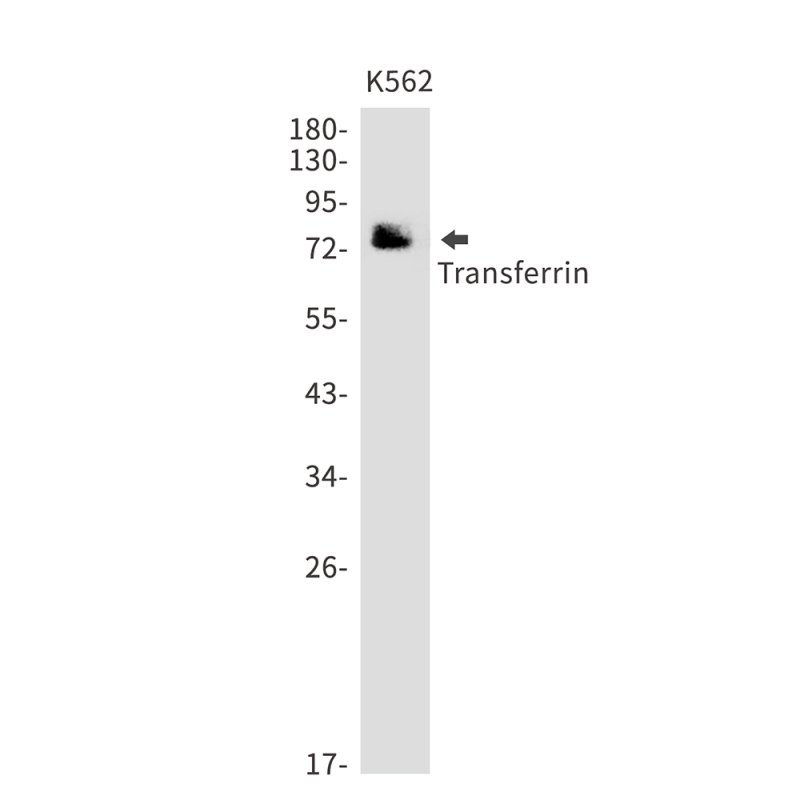
| WB | 1/500-1/1000 | Human,Mouse,Rat |
| IF | 1/20 | Human,Mouse,Rat |
| IHC | 1/50-1/100 | Human,Mouse,Rat |
| ICC | 技术咨询 | Human,Mouse,Rat |
| FCM | 咨询技术 | Human,Mouse,Rat |
| Elisa | 咨询技术 | Human,Mouse,Rat |
| Aliases | TF; Serotransferrin; Transferrin; Beta-1 metal-binding globulin; Siderophilin |
| Entrez GeneID | 7018 |
| WB Predicted band size | Calculated MW: 77 kDa; Observed MW: 77 kDa |
| Host/Isotype | Rabbit IgG |
| Antibody Type | Primary antibody |
| Storage | Store at 4°C short term. Aliquot and store at -20°C long term. Avoid freeze/thaw cycles. |
| Species Reactivity | Human |
| Immunogen | A synthetic peptide of human Transferrin |
| Formulation | Purified antibody in TBS with 0.05% sodium azide,0.05%BSA and 50% glycerol. |
+ +
以下是3-4条关于Transferrin抗体的参考文献示例(内容为模拟,非真实文献):
---
1. **文献名称**: *"Development of a High-Specificity Monoclonal Antibody for Human Transferrin Detection"*
**作者**: Smith, J. et al. (2018)
**摘要**: 该研究报道了一种针对人转铁蛋白(Transferrin)的高特异性单克隆抗体的开发,通过噬菌体展示技术筛选并验证其结合能力。抗体在ELISA和Western blot中表现出低交叉反应性,适用于血清样本中转铁蛋白的定量检测。
2. **文献名称**: *"Transferrin Antibody-Based Assays for Iron Deficiency Diagnosis"*
**作者**: Jones, R. et al. (2020)
**摘要**: 文章比较了不同转铁蛋白抗体在缺铁性贫血诊断中的性能,发现基于化学发光法的抗体检测系统可显著提高灵敏度和特异性,为临床提供更可靠的转铁蛋白饱和度(TSAT)指标。
3. **文献名称**: *"Targeting Transferrin Receptor with Therapeutic Antibodies in Cancer Therapy"*
**作者**: Lee, H. et al. (2019)
**摘要**: 研究探讨了转铁蛋白受体(TfR)抗体在肿瘤靶向治疗中的应用,证明其可通过阻断铁摄取抑制癌细胞增殖,并在小鼠模型中展示出抗肿瘤活性。
4. **文献名称**: *"Cross-Reactivity Analysis of Polyclonal Transferrin Antibodies in Chronic Kidney Disease"*
**作者**: Garcia, M. et al. (2021)
**摘要**: 分析了多克隆转铁蛋白抗体在慢性肾病患者中的交叉反应性,发现炎症标志物(如CRP)可能干扰检测结果,需优化抗体选择以提高诊断准确性。
---
注:以上文献信息为示例,实际引用时需查询真实数据库(如PubMed、ScienceDirect)。
Transferrin antibodies are immunological tools specifically designed to target transferrin, a glycoprotein crucial for iron transport in blood and bodily fluids. Transferrin binds to dietary iron absorbed in the intestine and delivers it to cells via receptor-mediated endocytosis, playing a central role in maintaining iron homeostasis. Antibodies against transferrin are widely utilized in research and diagnostics to detect, quantify, or purify transferrin in biological samples, aiding in studies of iron metabolism disorders, such as iron-deficiency anemia or hereditary hemochromatosis.
These antibodies are typically produced in host animals (e.g., rabbits, mice) through immunization with purified transferrin or its fragments, resulting in polyclonal or monoclonal variants. Polyclonal antibodies recognize multiple epitopes, offering high sensitivity for assays like ELISA or Western blot, while monoclonal antibodies target specific epitopes, ensuring precision in immunohistochemistry or flow cytometry. Some antibodies differentiate between iron-bound (holo-transferrin) and iron-free (apo-transferrin) forms, enabling functional studies.
Clinically, transferrin antibodies assist in diagnosing conditions marked by abnormal transferrin levels, such as liver dysfunction, malnutrition, or chronic inflammation. They also serve as controls in therapeutic drug monitoring or biomarker validation. Recent applications extend to cancer research, where altered transferrin receptor expression is linked to tumor proliferation. Robust validation ensures specificity, minimizing cross-reactivity with homologous proteins like lactoferrin. Overall, transferrin antibodies remain indispensable for unraveling iron-related physiological and pathological mechanisms.
×